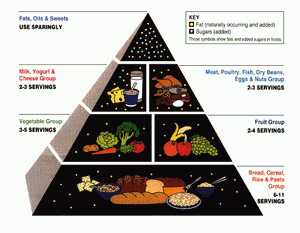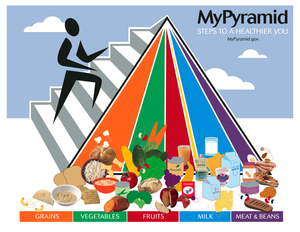USDA Replaces Food Pyramid with New Food Plate
On June 2, 2011, the USDA revealed its new food plate, a simplified version of the food pyramid which had been in existence since 1992. The pyramid, though, was often confusing for Americans, particularly children, so Michelle Obama has teamed up with the USDA and is hoping that the plate’s simplicity will be better able to exemplify the proportions of food that we should be consuming. Michelle Obama has been spearheading her “Let’s Move” campaign to get American kids healthier by eating nutritious foods and exercising more often. Currently, more than one-third of children and more than two-thirds of adults are overweight or obese in the United States.
The original 1992 food pyramid, which was confusing particularly to children, recommended five to nine servings of fruits and vegetables and six to eleven servings of bread, rice, pasta, and cereal. This pyramid, however, was misleading, as it did not differentiate between refined and whole grains.
 1992 Pyramid image source
1992 Pyramid image source
In 2005, MyPyramid was created with the motto “Steps to a Healthier You.” It contained a stick figure climbing steps to emphasize the need for activity in a healthy lifestyle.
Each food group had a thicker base and became thinner as it reached the top of the pyramid. This illustrated the fact that within each food group there are healthier foods which should be eaten more frequently (base) and less healthy foods to eat more sparingly (top). For example, both whole wheat couscous and donuts are classified as grains. Certainly we can all agree, whole wheat couscous would be classified at the bottom while donuts at the top!
According to the USDA, “MyPlate illustrates five food groups using a familiar mealtime visual, a place setting.” The new plate contains four segments: half of the plate contains fruits and vegetables, and the other half is filled with proteins and grains. In addition, there is a glass of milk to the side of the plate to represent the need for dairy as a part of a healthy diet. Grains are less dominant on the new plate, though carbohydrates are still represented by the large fruit and vegetable portion. Absent are healthy fats-a required part of every diet, and any visual representation of physical activity-something we here at Sargent Choice miss dearly.
Furthermore, MyPlate now describes discretionary calories as empty calories. Here at Sargent Choice we prefer the term elective calories. We realize that sometimes a plate of French fries or brownie sundae is exactly what you want. It may not be nutritious, but it gives you something else that you need. 100% pure pleasure. That’s what elective calories should be for you. A real treat. And we think there’s nothing “empty” about that!
The new food plate is in line with the 2010 Dietary Guidelines for Americans, which was revealed in January 2011. In the USDA’s updated guidelines, the government is encouraging Americans to avoid super-sized portions, make half of your plate fruits and vegetables, switch to low-fat or fat-free dairy products, read labels to avoid high-sodium foods, drink water instead of sugary drinks like soda, and, in general, to simply eat less.
To coincide with the new plate, the USDA created an interactive website, Choosemyplate.gov. The site contains interactive tools, tips, and recipes. The White House chef appeared on Good Morning America and The Today Show to highlight how easy it is to make healthy, delicious meals that follow these guidelines.
Marion Nestle, a professor in the department of nutrition, food studies, and public health at New York University, told CNN, “We are people…We don’t eat pyramids. We eat off of plates.” Nestle also pointed out that the American Institute for Cancer Research, the American Diabetes Association, and Canada’s Food Guide have all adopted similar plate models. It is important, though, to remember that the more food that’s put in front of someone, the more one will tend to eat. So keep plate sizes reasonable.
According to the USDA, “MyPlate is part of a larger communications initiative based on 2010 Dietary Guidelines for Americans to help consumers make better food choices. MyPlate is designed to remind Americans to eat healthfully; it is not intended to change consumer behavior alone.”
What do you think of MyPlate?


7 Comments
Kristen Pufahl posted on June 10, 2011 at 11:37 am
Nice work Alyssa!
Alyssa Langer posted on July 29, 2011 at 7:14 pm
Thank you!
1-butyl-2,3-dimethylimidazolium nitrate posted on October 31, 2022 at 11:08 am
Alfa Chemistry is a global leader in the field of ionic liquids. We have the ability to help developers solve the challenges of ionic liquids in various applications. Alfa Chemistry believes that partnerships will change the way the world innovates, bringing new technologies.
Tabelacı posted on December 7, 2022 at 7:03 pm
thankss
ankara disleksi posted on September 16, 2023 at 5:12 am
danke şöAnkara Disleksi
ankara travesti posted on October 17, 2023 at 7:00 am
good post very likeAnkara Travesti
numarecoverycenters posted on January 3, 2024 at 10:14 am
The shift from the food pyramid to the simplified food plate marked a crucial step in promoting healthier eating habits, championed by Michelle Obama’s “Let’s Move” campaign. Clearer guidelines help tackle the alarming rates of obesity, emphasizing balanced nutrition and physical activity for a healthier future.